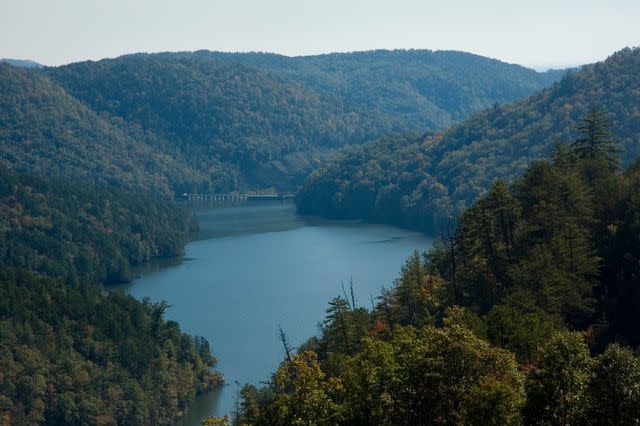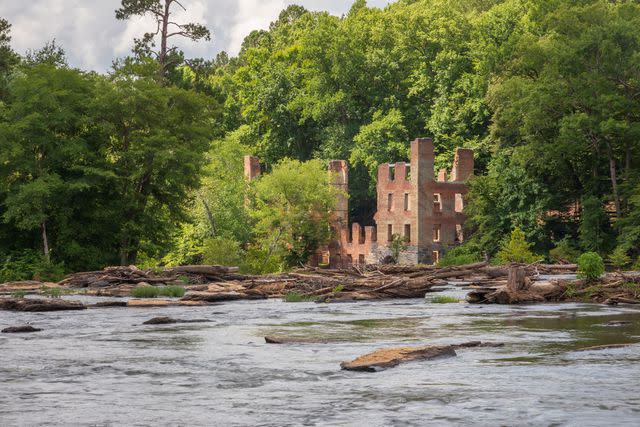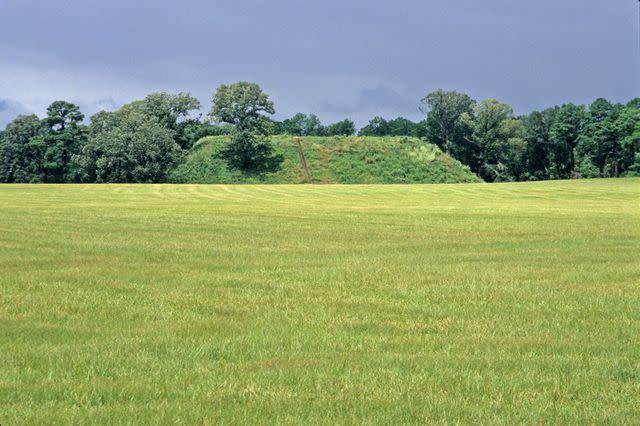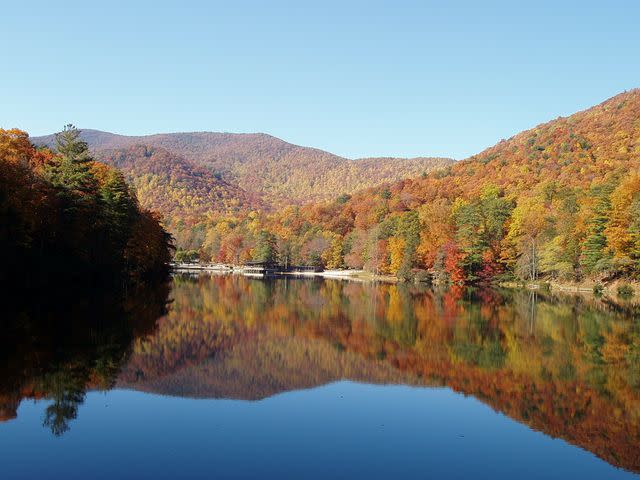The 10 Best State Parks In Georgia
Here's where to hike, explore, and meander in The Peach State.

courtesy of Georgia State Parks & Historic Sites
One of the many perks of living in the South is being surrounded by incredible landscapes. In Georgia, for example, you can just as easily spend your day hiking a mountain peak as kayaking along the coast. Many of the Peach State's parks are ready for adventure regardless the season. From hiking trails brimming with bright fall foliage to waterfalls and waterfronts to cool off summer vacationers, there's always a park to explore. The Georgia Department of Natural Resources compiles all of The Peach State’s parks in one place to help you plan too. Whether you’re looking to fish, bike, camp, or simply take in some scenery, these are the best state parks in Georgia.
Providence Canyon

courtesy of Georgia State Parks & Historic Sites
Nicknamed Georgia’s little canyon, this state park was caused accidentally. In fact, the massive, albeit picturesque, gullies were made because of poor farming practices during the 1800s. Today, visitors flock to the canyons to take in the soil’s pink, orange, red, and purple coloring. It’s like seeing a painting come to life. Enjoy the views of the canyons below from the rim trail, or take the 2.5-mile loop trail to see canyons one through nine.
Tallulah Gorge

courtesy of Georgia State Parks & Historic Sites
Located in the northeastern part of the state just minutes from the South Carolina border, Tallulah Gorge is two miles long and nearly 1,000 feet deep. Thrill seekers and novice hikers alike will get the best views of the gorge, river, and waterfalls from the 80-foot-high suspension bridge. For those looking to keep their feet on solid ground, there are several rim hikes offering scenic overlooks.
Cloudland Canyon

courtesy of Georgia State Parks & Historic Sites
Located near the northeast Alabama state line in northwest Georgia, Cloudland Canyon State Park is one of the largest parks in Georgia. It offers 3,538 acres to explore by foot, bike, or horse. There are thousand-foot-deep canyons, sandstone cliffs, waterfalls, disc golf, and geocaching. For those looking to stay overnight, there are 72 campsites.
Skidaway Island

courtesy of Georgia State Parks & Historic Sites
Savannah is a popular destination due to its charming historic district and beautiful squares, but it also draws an outdoorsy crowd too thanks to Skidaway Island State Park. Here, along Georgia’s Intracoastal Waterway, visitors can explore trails that bend through maritime forests and marsh. Wildlife such as crabs, egrets, and deer are often found here as well. Overnight accommodations include campsites as well as cabins with screened porches and (gasp!) air conditioning.
Roosevelt’s Little White House

courtesy of Georgia State Parks & Historic Sites
Before Franklin Delano Roosevelt became America’s 32nd president, he built the Little White House in Warm Springs, Georgia. He hoped to find a cure for his debilitating polio in the 88-degree buoyant water found nearby. While the pools are closed for swimming today, visitors can learn about FDR and his vision at the home and museum.
Stephen C. Foster

Georgia Department of Natural Resources
This state park is one of the main entrances to the largest wetland in the South, the Okefenokee Swamp. It is a 402,000-acre refuge for turtles, raccoons, black bears, deer, numerous birds, and more. It is also estimated that 12,000 alligators live within the refuge, too. Visitors can rent canoes or opt for guided boat tours to take in the swamp and its many critters. This park is an ideal spot for nature photographers as well, but please keep your pets at home. Pets are not allowed in boats.
Sweetwater Creek

courtesy of Georgia State Parks & Historic Sites
This state park is a still refuge just a few minutes from Atlanta’s bustling city center. Trails covered in the tree canopy follow the stream and the 215-acre George Sparks Reservoir. The reservoir serves as a popular spot for recreational sports including canoeing, kayaking, and fishing. The park also draws visitors seeking the ruins of the New Manchester Manufacturing Company, an old textile mill. You might also recognize the mill ruins from many movies, including The Hunger Games.
Kolomoki Mounds

courtesy of Georgia State Parks & Historic Sites
This state park is one of the most historically significant sites in Georgia as well as the Southeastern U.S. It is the oldest and largest Woodland Indian site and was occupied by indigenous peoples from 350 to 750 A.D. Here, you will find a great temple mound, as well as two smaller burial mounds and several ceremonial mounds. There is a museum dedicated to telling the story of the people who once lived here as well as the park itself.
Unicoi

courtesy of Georgia State Parks & Historic Sites
Explore 1,029 acres as well as the 53-acre Unicoi Lake at Unicoi State Park. The park is a convenient road trip from Atlanta, making it a popular day destination from the city. Activities at Unicoi include ziplining, archery, and fly fishing. Leashed dogs are also welcome for hikes! The most popular activity at Unicoi, however, is camping. There are nearly 100 campsites of varying types, including glamping tents complete with home decor and coffee makers. For those seeking a more Troop Beverly Hills experience, check out the Lodge.
Vogel

courtesy of Georgia State Parks & Historic Sites
This state park is Georgia’s second oldest. It was established in 1931 and is found at the base of Blood Mountain in the Chattahoochee National Forest. This park is best known for being in the center of Georgia’s leaf-peeping region, so fall is the prime time to visit. In addition to moderate hiking trails, there is also a 13-mile backcountry trail to explore. Don’t miss the Civilian Conservation Corps (CCC) museum which tells the story of the “CCC Boys.”
For more Southern Living news, make sure to sign up for our newsletter!
Read the original article on Southern Living.

